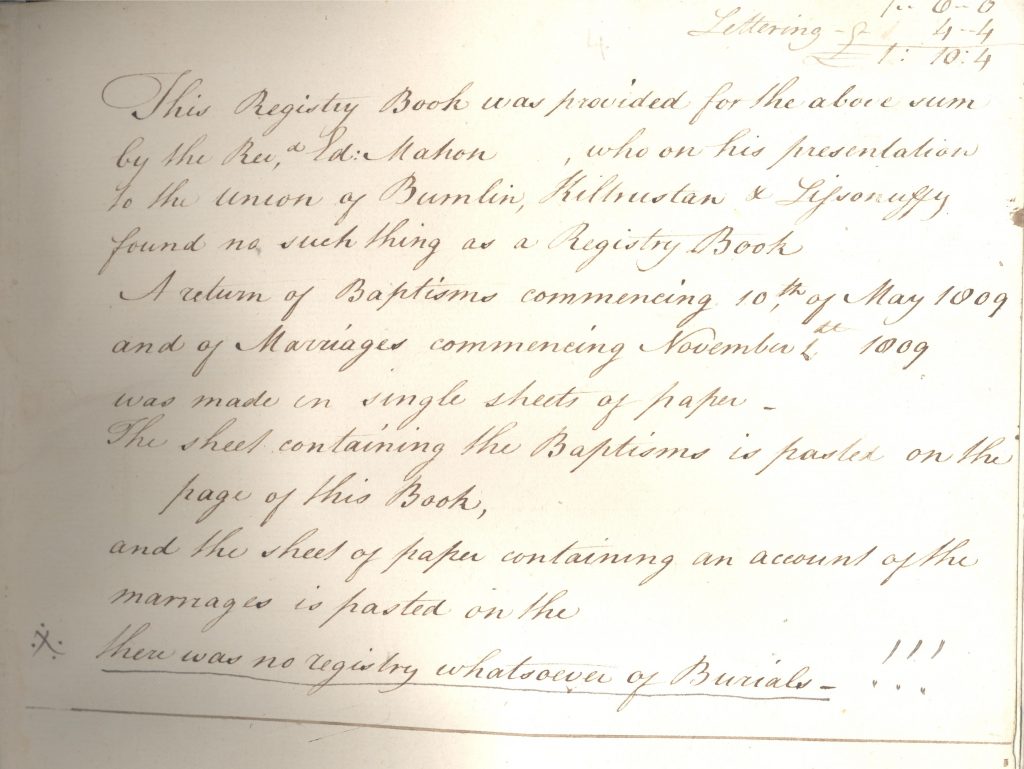The Strokestown (Bumlin) Parish Registers 1811-1969
Those with an interest in the Longford/Roscommon region might be particularly interested in the latest finding at the Representative Church Body Library. Below is transcribed content of the parish registers of the former union of Bumlin, Kiltrustan and Lissonuffy in Co. Roscommon, together with the memorial inscriptions on the monuments in the surrounding churchyard adjacent to the parish church of St John the Baptist, covering the period 1811-1969.
The parish of Bumlin centred on the landlord-planned town of Strokestown, where for over 300 years the Mahon (later Pakenham Mahon) family had their big house, which survives and today is the location of the Irish Famine Museum. Work on the parish registers which are located at the RCB Library (the Church of Ireland’s principal record repository) has again been carried out by local historian Alan Moran whose transcribed the Bumlin vestry minute book between 1811 and 1870 (available at this link: http://bit.ly/2BGXrwL
Collectively this work means that Strokestown is one of the first Church of Ireland parishes to have all of its principal historic records transcribed and available online. In accordance with best practice for online publication, the transcripts comprise baptisms and marriages 1811-1919, and burials and memorial inscriptions 1811-1969, and are fully indexed and searchable. The transcribed data is part of the Anglican Record Project, a long-running series of mainly Church of Ireland parish record transcriptions, initiated by Mark Williams and permanently available on the RCB Library website at www.ireland.anglican.org/about/rcb-library/anglican-record-project. Alan worked under the tutelage of Mark on the Bumlin registers and memorials inscriptions, and Mark’s input is specifically acknowledged. Their joint labour has made accessible for the first time a vast amount of ancestral and local history data that was hitherto relatively inaccessible.

The permissionsof the Director of the National Archives,with whom the reproduction rights of parish registers reside on behalf of the state to 1871, as well as the Representative Church Body, are acknowledged by the Project.
In 1751 Thomas Mahon MP of Strokestown House conveyed to the Bishop of Elphin an acre of land in Strokestown, for the purpose of erecting a new church, which was confirmed as the parish church in place of Bumlin in March 1754. The ancient church of Bumlin was by then “in a decayed and ruinous condition and the site thereof inconvenient” so the new church added to the embellishment of the new planned town he was developing. By 1813 the parish vestry sought a loan of £1,000 from the Board of First Fruits to add a tower and steeple to this building, neither of which were completed before the church was destroyed, apparently by a storm, in the winter of 1818/19, so eventually a new church building was consecrated on 27 August 1820 which remained in use until 1977, when it finally closed. The building was retained, however, and it re-opened as a heritage centre in 1982, and is now home to the Co. Roscommon Heritage and Genealogy Centre, and both it and the churchyard are well maintained.
The earliest surviving registers and vestry minute book were presented by the Revd Edward Mahon (1776/7–1847) on his appointment as vicar in 1811. Fortunately, they were retained in local custody and thereby escaped the disastrous destruction of the Public Record Office of Ireland in June 1922. In the preliminary pages of the earliest register, Mahon’s personal annotation reveals his conscientiousness to be a good record keeper: having “found no such thing as a Registry Book” and “no registry whatsoever of Burials!!!” he took it upon himself to provide the book, which he purchased for £1.10.4.